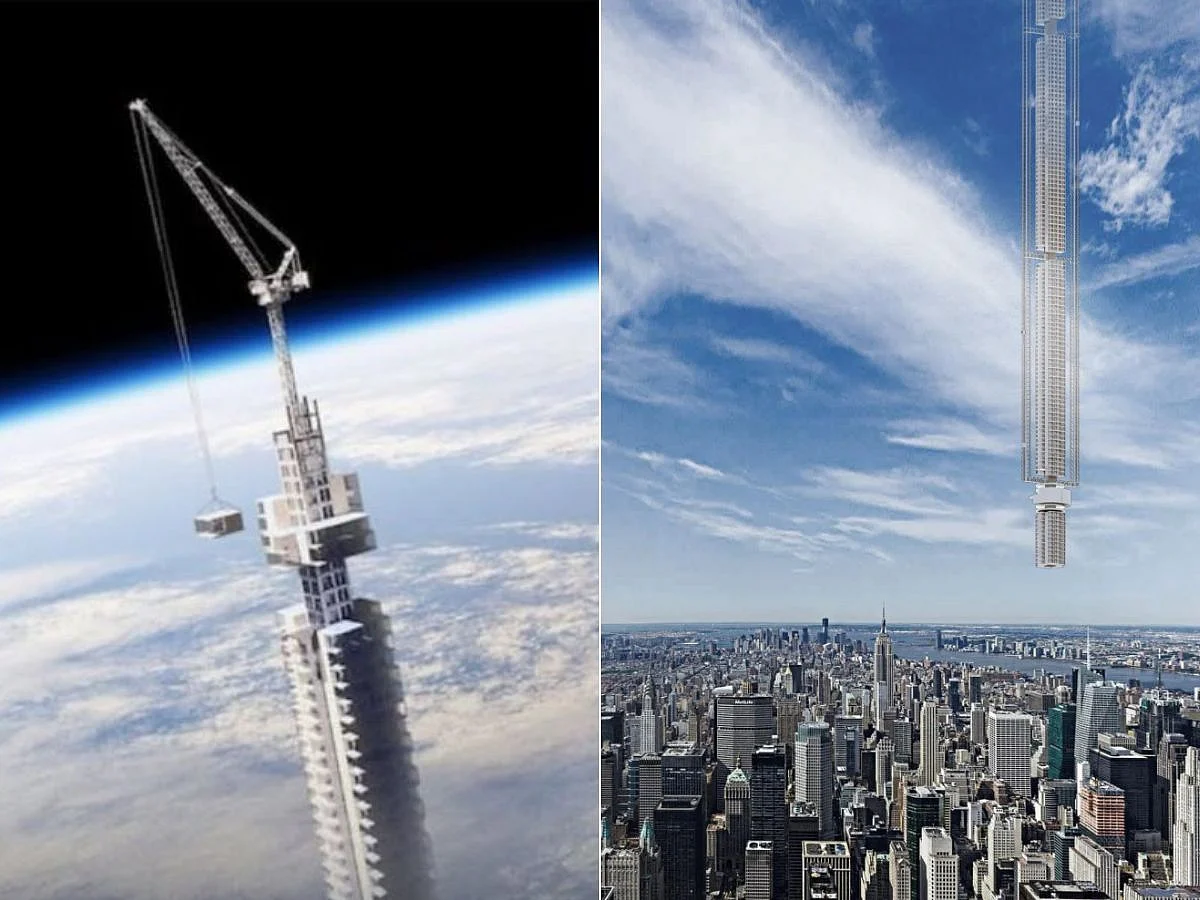Analemma 'Tower' hanging out in space? Meet the skyscraper dangling from the sky
Supertall tower dream suspended between the fiction and possibility

In recent years, architectural innovation has pushed the boundaries of what is possible on Earth.
But the Analemma Tower takes this ambition literally to new heights — suspended not from the ground, but from space itself.
Designed by the New York-based “interdisciplinary firm” Clouds Architecture Office (Clouds AO), the Analemma Tower is a speculative architectural concept.
What is the Analemma Tower?
The Analemma Tower is conceived as the world’s tallest building. Unlike any skyscraper built before, it would not rise from a foundation on Earth.
Instead, it would be suspended from an asteroid placed in
geosynchronous orbit approximately 50,000 kilometers (31,000 miles) above Earth.
Skyscraper hanging down from an asteroid
The tower would hang down from this asteroid via a super-strong cable system called the Universal Orbital Support System (UOSS), effectively reversing the traditional notion of a building’s foundation.
What’s in the name?
The name “Analemma” refers to the figure-eight pattern the tower’s orbit would trace over the Earth’s surface during a 24-hour cycle.
This orbit would cause the tower to slowly wobble above different cities — such as Dubai, New York, Havana, and Panama City — but returning to the same position daily.
The tower’s lower levels would be closer to Earth for easy access, housing shops and residences, while upper levels would ascend into near-orbital altitudes for recreational or spiritual activities, offering unprecedented views and experiences.
The vision behind the concept
Clouds AO’s design taps into humanity’s growing desire for vertical expansion and extreme height, projecting a future where architecture transcends planetary boundaries.
Dr Ahmad Sabirin Arshad, President and Group CEO SIRIM Berhad Malaysia, posted on LinkedIn that Analemma is a radical idea — a "reverse skyscraper" hanging from an asteroid — "remains a highly theoretical proposal".
What will power the building?
The tower would be powered by space-based solar panels – sort of how the International Space Station (ISS) is powered.
Moreover, like the ISS, it will utilise advanced recycling systems for water and air, potentially capturing rainwater and condensate from clouds below.
The tower would follow a daily figure-eight trajectory between hemispheres, offering changing views and the ability to "dock" with Earth's surface at slow orbital points, with a proposed construction site above Dubai.
Powered by space-based solar panels and using cloud-captured water in a closed-loop system,
'Elevators without cables'
Electromagnetic elevators, free from cables, would enable movement between floors.
The designers imagine the tower as a “hybrid space” — part urban environment, part space habitat — offering residents a unique experience akin to traveling in orbit, with extended daylight hours and spectacular vistas.
The concept also includes “transfer zones” at the northern and southern turning points of the orbit, where asteroid hubs could dock or depart, facilitating access.
Is it for real or just science fiction?
Despite the technical sophistication and imaginative scope, the Analemma Tower remains firmly in the realm of speculative design and conceptual architecture.
It is not under construction, nor are there concrete plans or funding to realise it in the near future.
The idea first surfaced around 2017 and has since been updated, but it has found no practical backing or technological feasibility for actual implementation.
Experts and commentators widely regard the Analemma Tower as a visionary exploration of future possibilities rather than an imminent project.
It serves as a provocative thought experiment that challenges architects, engineers, and urban planners to rethink the limits of vertical living and space utilisation.
Not an April Fool’s joke, but a bold speculation
Unlike many outlandish ideas that appear on April 1st, the Analemma Tower is a serious conceptual project presented by a reputable architecture firm with detailed designs and scientific references.
It is not intended as a prank but as a speculative vision that pushes the envelope of architectural imagination.
Clouds AO themselves acknowledge the concept’s speculative nature, highlighting that many technological and societal advancements would be required before such a tower could become reality.
Aspirational
The Analemma Tower stands as a symbol of human aspiration to transcend earthly constraints and explore new frontiers in architecture and habitation.
While it is not a real building under construction, nor likely to be built in the foreseeable future, it sparks valuable conversations about the future of urbanism, space technology, and sustainable living.
For now, the Analemma Tower remains a breathtaking architectural dream suspended between the realms of science fiction and future possibility — a reminder that today’s imagination can be tomorrow’s reality.
Why is it impractical (at present)?
There are a number of reason why a project like Analemma will remain an architectural concept, or aspirational:
Asteroid capture and orbit control: While NASA and other space agencies have explored asteroid capture missions (such as the now-canceled Asteroid Redirect Mission), placing and maintaining an asteroid in a precise geosynchronous orbit for decades is beyond current capabilities and would require enormous resources.
Material and structural challenges: The cable needed to suspend a massive skyscraper from space would have to be extraordinarily strong and resilient to withstand orbital dynamics, atmospheric conditions, and space debris — technology that does not yet exist.
Human habitation issues: The tower’s upper sections would be at near-space altitudes, exposing occupants to extreme cold, near-vacuum conditions, and radiation, necessitating advanced life-support systems and protective gear.
Economic and logistical hurdles: The colossal cost and complexity of building, maintaining, and operating such a structure make it unfeasible with today’s technology and economics.
Yet, as history shows, many ideas once deemed science fiction — like skyscrapers, airplanes, or space stations — eventually materialised.
Sign up for the Daily Briefing
Get the latest news and updates straight to your inbox
Network Links
GN StoreDownload our app
© Al Nisr Publishing LLC 2026. All rights reserved.